Kaburaki Kiyokata and Hirezaki Eiho – Illustrations bringing color to modern literature

The Unknown Rivalry –Kaburaki Kiyokata and Hirezaki Eihō
With the rediscovery of “Tsukiji Akashi-chō” in 2019, Kaburaki Kiyokata (1878-1972) gathered attention. Although he is known as a painter of Japanese art, he was also active in the genre called kuchi-e (illustrations for magazines and novels) from 1903 to 1916. At the time, Hirezaki Eihō (1881-1968) was popular alongside Kiyokata. Kiyotaka and Eihō both succeeded Yoshitoshi Tsukioka, and they were friends who belonged to the same art association. We will introduce the masterpieces of kuchi-e prints of beautiful women by Kiyokata and Eihō from the Meiji Era.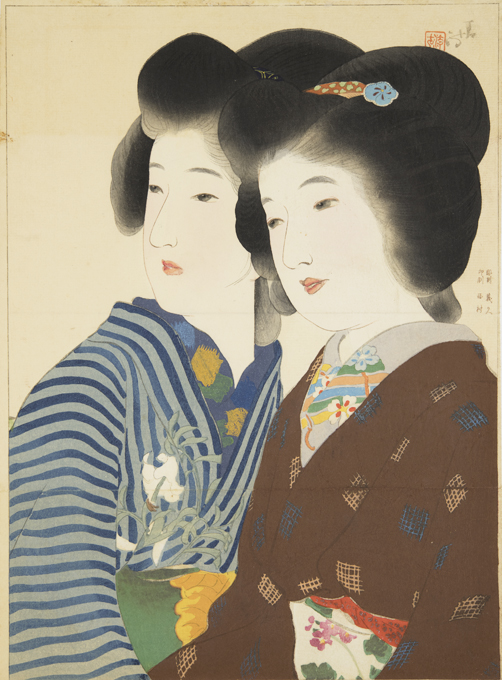
Kaburaki Kiyokata “Illustration for “Yuriko” (Vol. 3) by Kikuchi Yūhō” 1913 ⒸAkio Nemoto
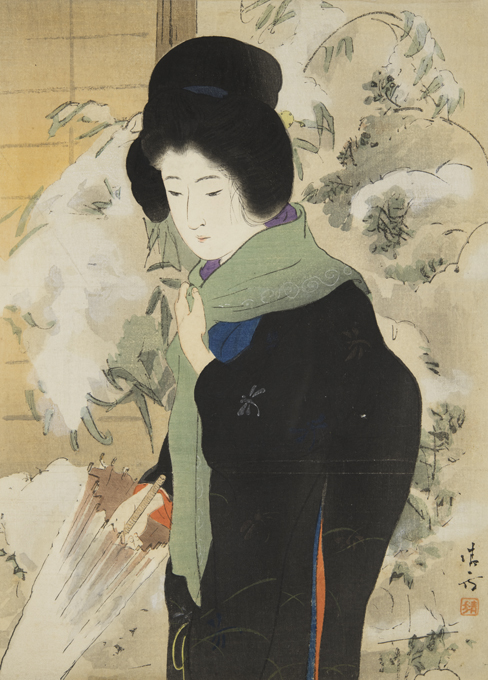
Kaburaki Kiyokata “Illustration for “Koyuki” (Vol. 2) by Kikuchi Yūhō” 1913 ⒸAkio Nemoto

Hirezaki Eeihō “Illustration for “Chikai” (Vol. 1) by Yanagawa Shunyō” 1915

Hirezaki Eeihō “Illustration for “Chikai” (Vol. 2) by Yanagawa Shunyō” 1917
The Unknown Woodblock Prints with Excellent Techniques
From the late 20s of Meiji Era to the early Taishō Era, kuchi-e prints made with woodblocks were used in the opening pages of the magazines and novels. Kuchi-e which brilliantly illustrated stories, did not simply inherit the mastery of ukiyo-e from the Edo period, but largely surpassed its techniques with delicate carving and painting. However, as they are rarely studied by current ukiyo-e researchers, they had been a forgotten genre. We have chosen 110 pieces from the collection by a kuchi-e collector, Asahi Tomoo to highlight the beauty of kuchi-e prints.
Kaburaki Kiyokata “Illustration for “Nise Murasaki” (Vol. 2) by Izumi Kyōka” 1905 ⒸAkio Nemoto

Hirezaki Eihō “Illustration for “Fukagawa-zome” (Vol. 1) by Izumi Shatei and Izumi Kyōka” 1907
Unknown Illustrators –Keishū, Eisen, Toshikata and Hanko
Kuchi-e prints used in the opening pages of magazines and novels were produced by more than 100 artists since the late 20s of the Meiji period. Popular artists before Kiyokata and Eihō, were Takeuchi Keishū (1861-1943), Tomioka Eisen (1864-1905), Mizuno Toshikata (1866-1908) and Kajita Hanko (1870-1917). Among them, Mizuno Toshikata, the master of Kaburaki Kiyokata, is an essential artist to study in order to understand the artworks of Kiyokata. We will introduce these four illustrators along with Kiyokata and Eihō.
Takeuchi Keishū “Beautiful Woman Catching Fireflies (Illustration for “Bungei-kurabu” Vol. 3, No. 10)” 1897

Tomioka Eisen “Illustration for “Kareno no Makuzu” by Mizutani Futō” 1897

Kajita Hanko “Fragrance of Chrysanthemum (Illustration for “Bungei-kurabu” Vol. 11, No. 13) 1905

Mizuno Toshikata “Illustration for “Tōsei Gonin Otoko no Uchi Kurahashi Kōzō” (Vol. 3) by Murakami Namiroku”
Featured work
Hirezaki Eihō “Illustration for “Zoku Fūryūsen” by Izumi Kyōka” 1905
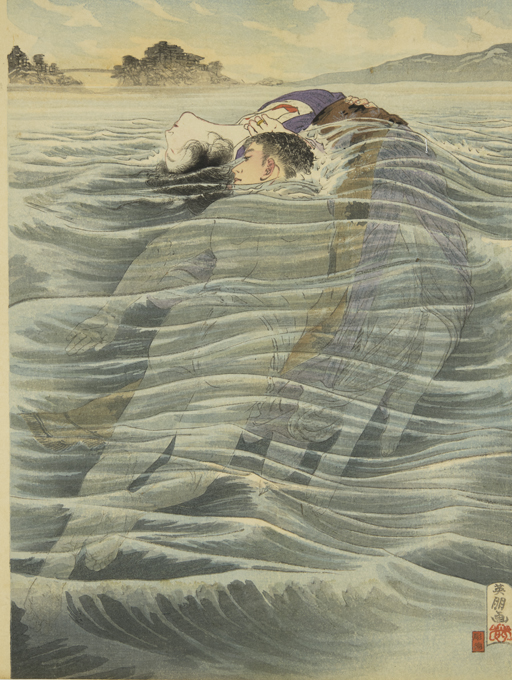
Admission
| Adult | 1000 yen |
|---|---|
| University and High school students | 700 yen |
| Junior High School Students and below | Free |
Calendar
-
-
-
-
2020 February
SUN MON TUE WED THU FRI SAT 1 2 3 4 5 6 7 8 9 10 11 12 13 14 15 16 17 18 19 20 21 22 23 24 25 26 27 28 29 -
2020 March
SUN MON TUE WED THU FRI SAT 1 2 3 4 5 6 7 8 9 10 11 12 13 14 15 16 17 18 19 20 21 22 23 24 25 26 27 28 29 30 31
-
-
-
Masterpieces of ukiyo-e paintings from Ota Memorial Museum of Art

Ōta Memorial Museum of Art located in Harajuku specializes in ukiyo-e. The museum has a collection of about 14000 pieces that were mainly collected by Seizō ŌtaⅤ(1893~1977), who was the former president of the Toho Mutual Life Insurance Company, throughout his lifetime. Since the museum in Harajuku opened in January 1980, it has continued to be active as one of the few museums specializing in ukiyo-e in Tokyo, and celebrates its 40th anniversary this January. Commemorating this, we will exhibit selected nikuhitsu-ga (hand-painted pictures) from our wide-range of collections in this exhibition. Compared to ukiyo-e woodblock prints which are made by the combined labor of painters, carvers and printers, nikuhitsu-ga are drawn by the artist. We can see the artists’ brush strokes and understand their techniques from nikuhitsu-ga. Started from Hishikawa Moronobu, the ukiyo-e artist of the early period, we will introduce the masterpieces of famous artists such as Kitagawa Utamaro, Katsushika Hokusai and Utagawa Hiroshige, and Kobayashi Kiyochika and Tsukioka Yoshitoshi who were artists active in the Meiji Era. We would also like to you to enjoy the competition of the genius father and daughter Katsushika Hokusai and Katsusika Ōi’s works: “Tiger in the Rain” painted by Hokusai in the year of his death at the age of 90, and “Courtesans Displaying Themselves through the Lattice in Yoshiwara” painted by Ōi, whose total number of confirmed works worldwide is only about 10 pieces.
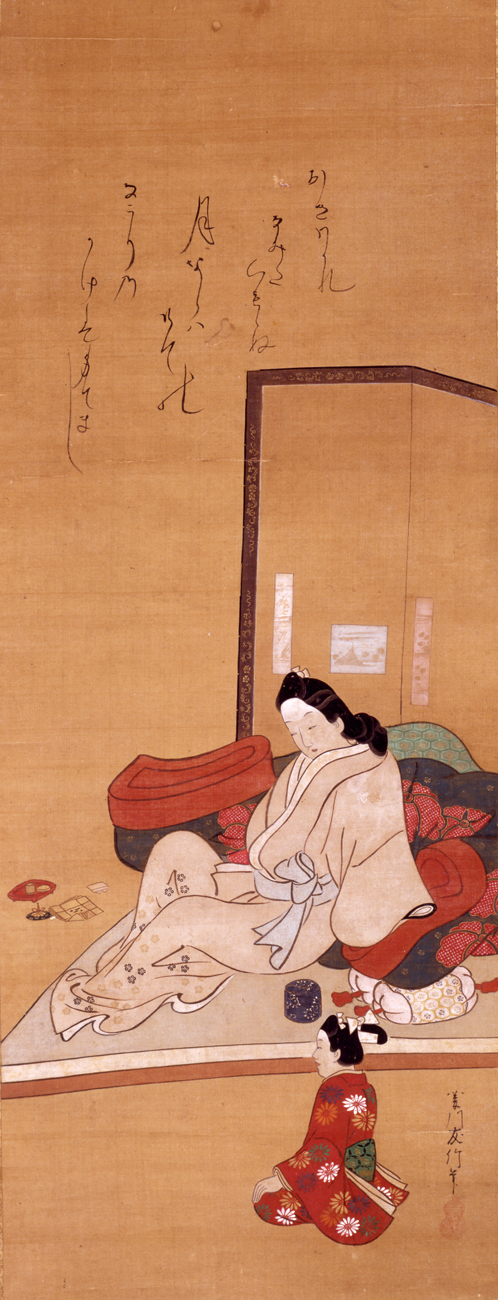
Hishikawa Moronobu “Courtesan Being in a Pensive Mood”

Katsukawa Shunshō “Kitten and a Woman”
Marking the 40th anniversary of Ōta Memorial Museum of Art
Late Seizō Ōta Ⅴ had learnt that ukiyo-e was highly valued overseas while traveling to Western countries, and started to collect ukiyo-e after being fascinated by the kachō-ga (flower-and-bird paintings) of Katsushika Hokusai exhibited at The Art Institute of Chicago. The size of the collection he made throughout his life reached about 12,000 works, and the Ōta Memorial Museum of Art was opened after his death by his bereaved family on January 13th, 1980. Ōta Memorial Museum of Art is one of the few museums specializing in ukiyo-e in Tokyo and has been holding exhibitions on various themes and promoting the appeal of ukiyo-e; we will mark the 40th anniversary of the opening of the museum this January, 2020.

Kuwagata Keisai “Cherry Blossom Viewing Party”

Tsukioka Yoshitoshi “Lady Tokiwa and Her Children Wandering in the Snow”
A fine collection of precious masterpieces by successive generations of ukiyo-e artists
The collection at Ōta Memorial Museum of Art is known as a well-balanced collection, consisting of both woodblock prints and hand-painted ukiyo-e, from various artists and periods. We carefully selected only the famous hand-painted works for this exhibition. Starting from Hishikawa Moronobu, a succession of exhibits will follow – Kaigetsudō School, Miyagawa School, Katsushika School such as Torii Kiyonaga, Kitagawa Utamaro, Katsushika Hokusai and Ōi, Utagawa School such as Utagawa Toyoharu, Toyokuni, Kuniyoshi and Hiroshige, and Kobayashi Kiyochika and Tsukioka Yoshitoshi who were active during the Meiji period. Please enjoy the fine hand-painted works by famous artists that illuminate the long history of ukiyo-e.

Katsushika Hokusai “The Tale of Genji, Scene of Hanano-en Chapter”

Utagawa Hiroshige Kitagawa Utamaro “Courtesan Reading a Letter”
The actual brushwork of ukiyo-e artists seen in the nikuhistu-ga masterpieces

Kobayashi Kiyochika “Ryōgoku-bashi Bridge in Civilized Tokyo”
Most ukiyo-e works are made using the woodblock print method by the skills of artists who draw the sketches, carvers and painters. Since the sketches by the artists get carved into the woodblocks by the carvers and are lost, there is no way for us to see the original brushwork of the artists. Compared to this, hand-painted ukiyo-e (nikuhitsu-ga) is the only kind of work for which the artist receives an order and draws directly on paper or silk. We are able to see the original skills of ukiyo-e artists such as the delicate curves and color gradation, and also can enjoy the beauty of the richly utilized inks.

Utagawa Hiroshige “Kegon Falls in Nikkō” “Kirifuri Falls in Nikkō” “Urami Falls in Nikkō”
Featured work

Katsushika Hokusai “Tiger in the Rain”
Katsushika Hokusai “Tiger in the Rain”
Katsushika Ōi “Courtesans Displaying Themselves through the Lattice in Yoshiwara”
Father and the daughter – Competition of two genius artists
In this exhibition, two of the most famous works at Ōta Memorial Museum of Art, “Tiger in the Rain” by Katsushika Hokusai and “Courtesans Displaying Themselves through the Lattice in Yoshiwara” by Katsushika Ōi will be on display together. “Tiger in the Rain” by Katsushika Hokusai is a masterpiece drawn in 1849, the year of Hokusai’s death. The powerful vitality of the tiger staring up at the sky in the rain, seems to symbolize the unflagging soul of Hokusai as an artist at the age of 90. It is also known as the masterpiece that in 2005 was found to be paired up with “Dragon” housed at Guimet Museum in France. Also, the work by the daughter of Hokusai, Katsushika Ōi. “Courtesans Displaying Themselves through the Lattice in Yoshiwara”, which will be on display for the first time in two years, is known as one of the representative pieces of the rare works by Ōi. It dramatically depicts the pleasure quarters of Edo and the night in Yoshiwara by the bold depiction of the light and shadows, and the figures of people emerging in the dark give it a dreamy atmosphere. There is a story that Hokusai said he was no match for Ōi at drawing pictures of beautiful women, and her extraordinary talent is clearly shown in this picture.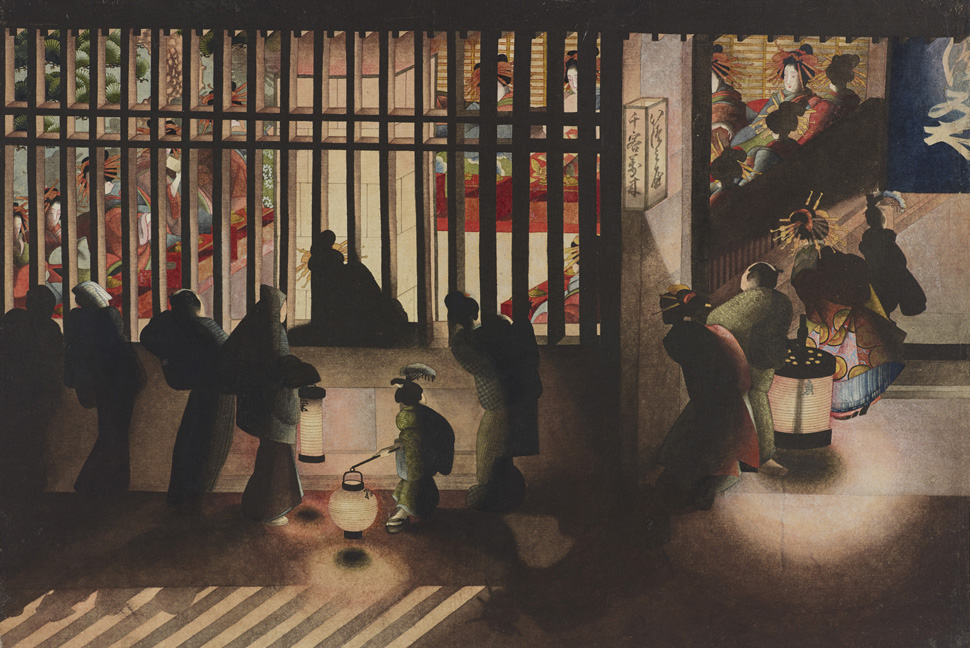
Katsushika Ōi “Courtesans Displaying Themselves through the Lattice in Yoshiwara”
Admission
| Adult | 700 yen |
|---|---|
| University and High school students | 500 yen |
| Junior High School Students and below | Free |
Calendar
-
-
-
-
2020 January
SUN MON TUE WED THU FRI SAT 1 2 3 4 5 6 7 8 9 10 11 12 13 14 15 16 17 18 19 20 21 22 23 24 25 26 27 28 29 30 31 -
2020 February
SUN MON TUE WED THU FRI SAT 1 2 3 4 5 6 7 8 9 10 11 12 13 14 15 16 17 18 19 20 21 22 23 24 25 26 27 28 29
-
-
-
Last Ukiyoe -inheritors of ukiyo-e

Discovering the ukiyo-e of the Meiji period lost in history
Many people understand ukiyo-e as a culture of the Edo period. However, ukiyo-e was continuously produced until the end of the Meiji period, in the beginning of the 20th century. Since their artistic value are disregarded, they are rarely introduced in museums today. This exhibition will discover 220 pieces of ukiyo-e from the Meiji period lost in history, from the collection of a painter and ukiyo-e collector, Isao Toshihiko.
Migita Toshihide “Genroku-style Dance at Shinbashi” (second term)

Nakazawa Toshiaki “Snow, the Moon and Flowers: Moon at Gojo Bridge” (first term)
Exploring the talent of 37 last ukiyo-e artists
Artists in the Meiji period such as Tsukioka Yoshitoshi and Kobayashi Kiyochika are often referred to as the last ukiyo-e artists. However, there were many artists after them in the following generation, striving to establish a new style during changing times. We will introduce the “Last Ukiyo-e” drawn by 37 artists such as Utagawa YoshimuneⅡ, Migita Toshihide, Mizuno Toshikata, Yōshū Chikanobu, Ogata Gekkō, Yamamoto Shōun and Miyagawa Shuntei, whose works were rarely presented until now.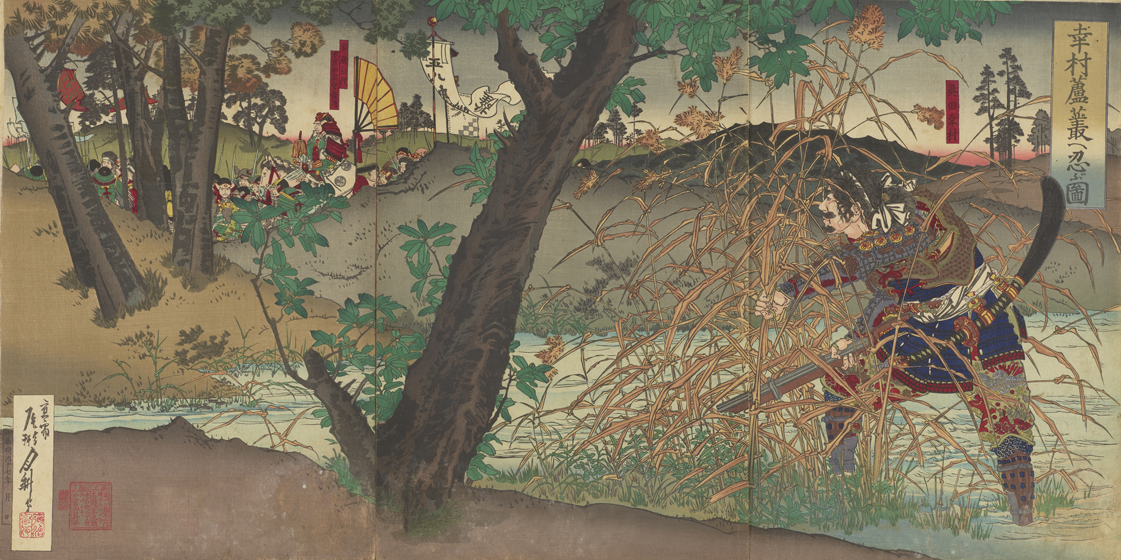
Ogata Gekkō “Picture of Sanada Yukimura Hiding Himself in the Reeds” (second term)
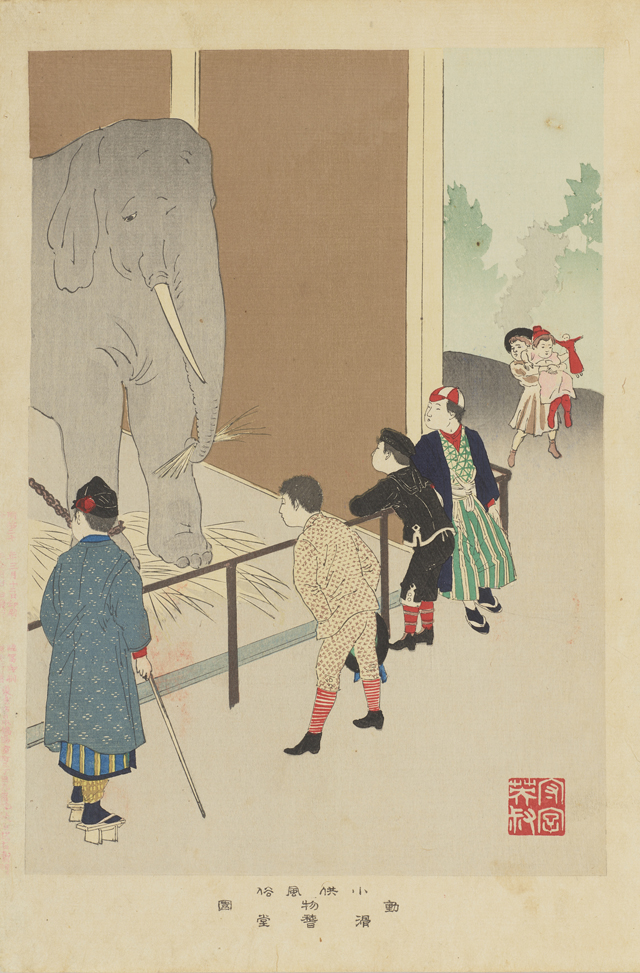
Miyagawa Shuntei “Various Aspects of Children: Zoo” (second term)

Yamamoto Shōun “Contemporary Figures: Shamisen (Japanese instrument)” (first term)
Pictures of beautiful women and the warriors with new painting styles

Utagawa Yoshimune Ⅱ “Sketches by Yoshimune: Abalone Gathering” (second term)

Ogata Gekkō “Bitter Melons and a Dragon-fly” (first term)
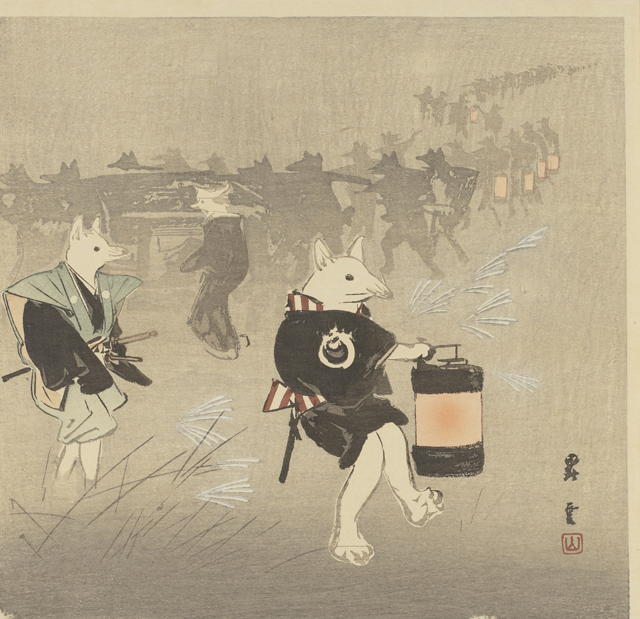
Yamamoto Shōun “Fox’s Wedding” (second term)
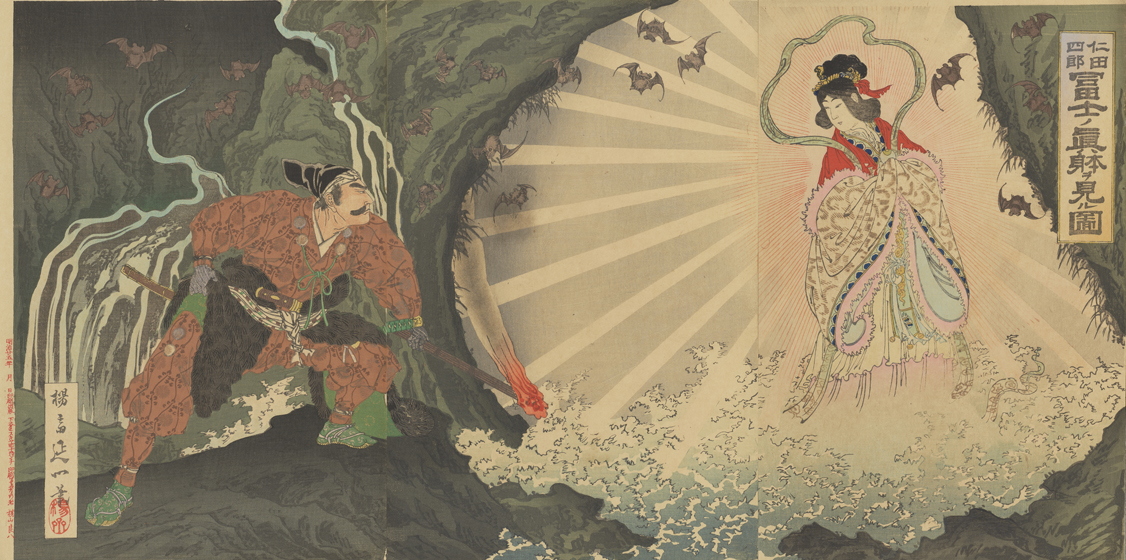
Yōsai Nobukazu “Nitta Shirō Watching the God of Mt. Fuji” (first term)
Developing a deep understanding of the history of ukiyo-e “Autumn fest of the Utagawa School”
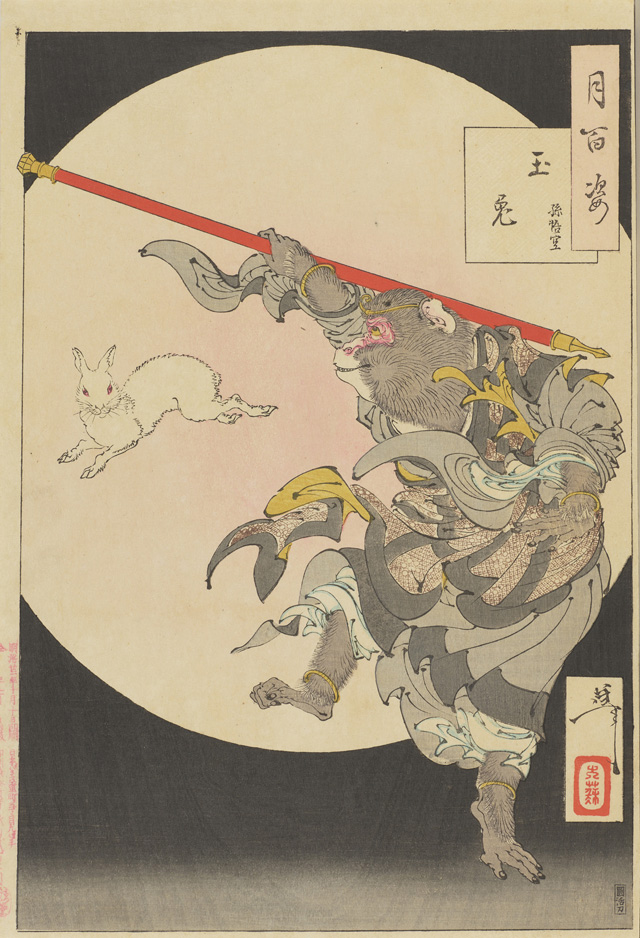
Tukioka Yoshitoshi “One Hundred Views of the Moon: Moon on Hazy-night: Jade Rabbit and Sun Wukong” (second term)

Mizuno Toshikata “Arhat, Nakasaina-sonja” (first term)
Highlight of the exhibition
Migita Toshihide “Sketches by Toshihide: Hagoromo” (first term)
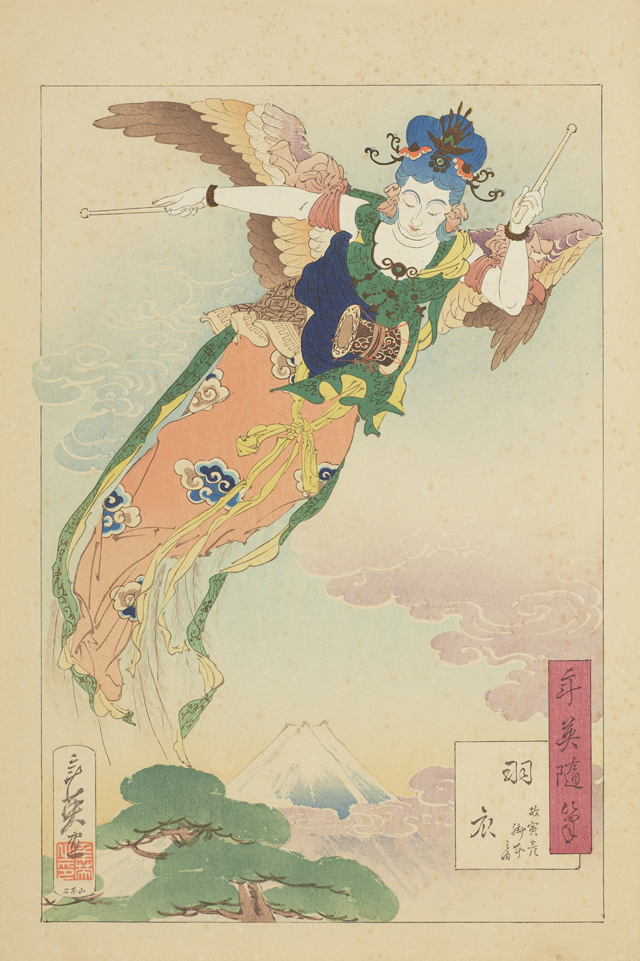
Admission
| Adult | 1000 yen |
|---|---|
| University and High school students | 700 yen |
| Junior High School Students and below | Free |
Calendar
-
-
-
-
2019 November
SUN MON TUE WED THU FRI SAT 1 2 3 4 5 6 7 8 9 10 11 12 13 14 15 16 17 18 19 20 21 22 23 24 25 26 27 28 29 30 -
2019 December
SUN MON TUE WED THU FRI SAT 1 2 3 4 5 6 7 8 9 10 11 12 13 14 15 16 17 18 19 20 21 22 23 24 25 26 27 28 29 30 31
-
-
-
Utagawa Kuniyoshi -And his daughters

Not just another Utagawa Kuniyoshi exhibition
Ukiyo-e artist Utagawa Kuniyoshi is rapidly gaining popularity for his vibrant pictures of samurai warriors and humorous parody pictures. Today, exhibitions of his works are held all over Japan. However, this exhibition hosted by Ota Memorial Museum of Art, which specializes in ukiyo-e, goes above and beyond. Introduced in addition to the great number of Kuniyoshi’s representative works are the works by Kuniyoshi’s two daughters, which received little attention until today.
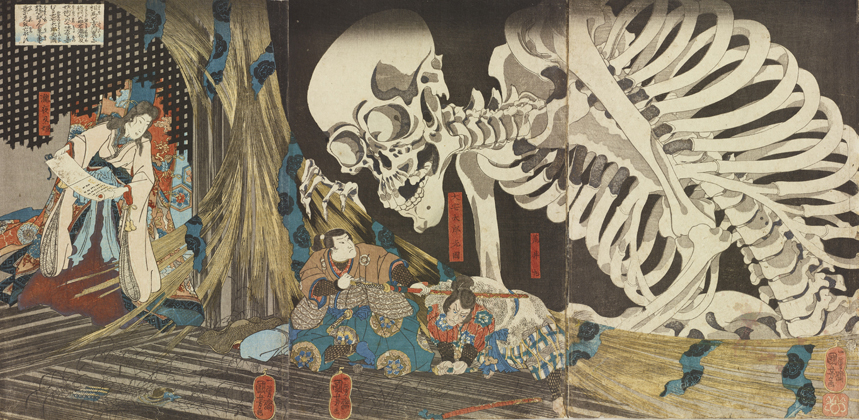
Utagawa Kuniyoshi “Takiyasha-hime Summoning a Skeleton at the Haunted Old Palace at Sōma”

Utagawa Kuniyoshi “Chinzei Hachirō Tametomo Rescued by Bird Long-nosed Goblins”
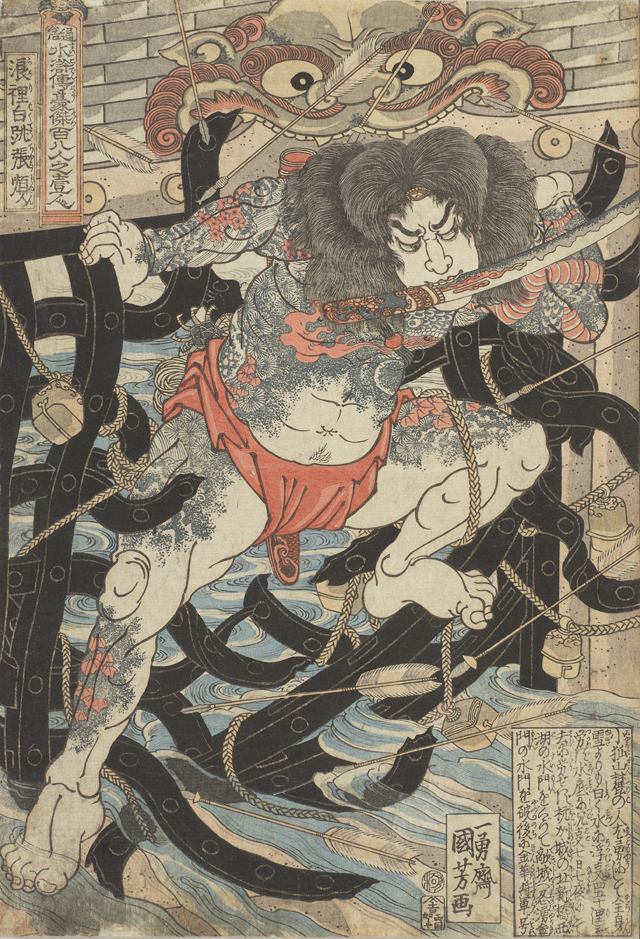
Utagawa Kuniyoshi “One Hundred and Eight Heroes from Tales of the Water Margin: Rōrihakuchō Chōjun”

Utagawa Kuniyoshi “Scribbles on a Storehouse Wall”
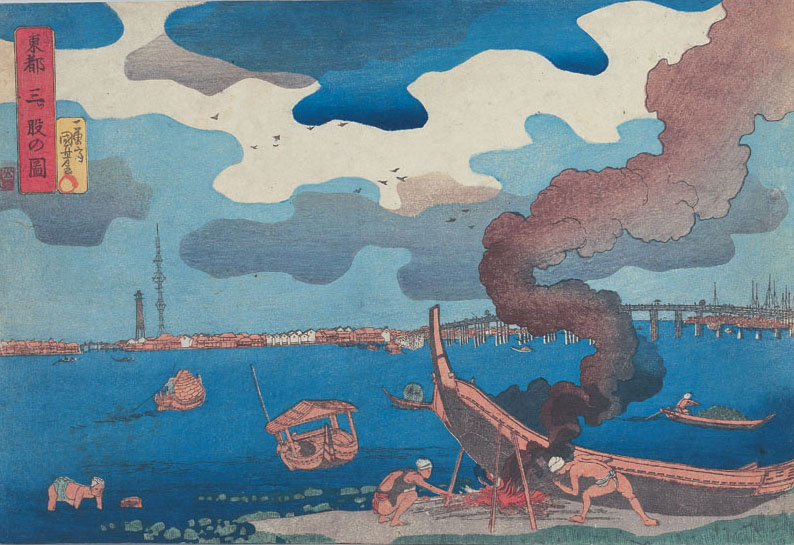
Utagawa Kuniyoshi “View of Mitsumata in Edo”
Kuniyoshi’s daughters were also ukiyo-e artists!
Katsushika Hokusai’s daughter Katsushika Ōi is well known when we speak of the daughter of an ukiyo-e artist. However, Ōi is not the only painter as the daughter of an ukiyo-e artist. Utagawa Kuniyoshi had two daughters and both of them had worked as ukiyo-e artists. His first daughter Tori worked as “Yoshitori” and his second daughter Yoshi worked as “Yoshijyo”. Most of their works were adding small drawings on Kuniyoshi’s work. Since each of them has only one painting known to be entirely their own, it is hard to say that they were full-fledged painters. They worked on ukiyo-e prints mainly in their teens. We can imagine them striving to paint ukiyo-e prints and help their father.
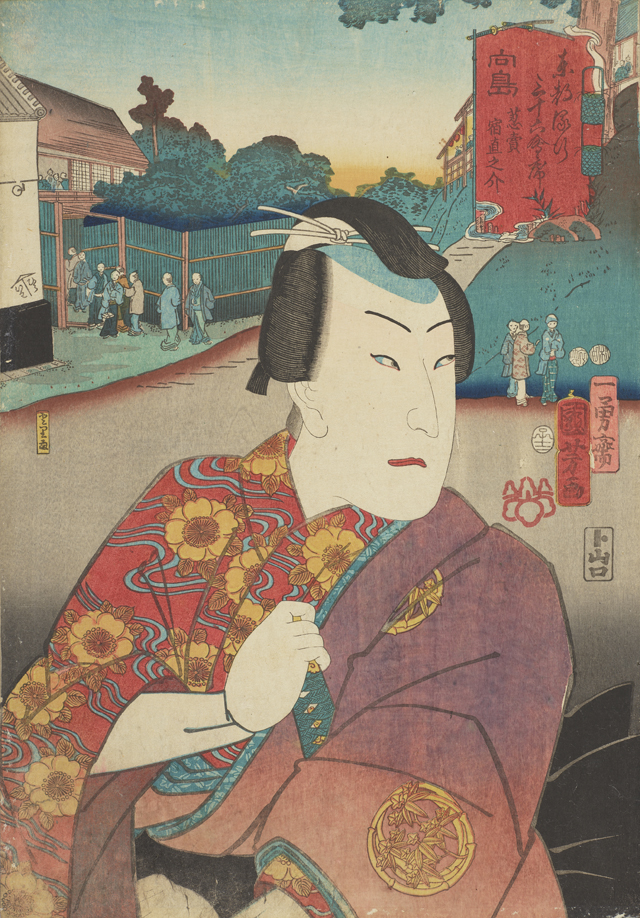
Utagawa Kuniyoshi / Utagawa Yoshitori “Thirty-six Famous Restaurants in Edo: Mukōjima, Negiuri Tomoinosuke”
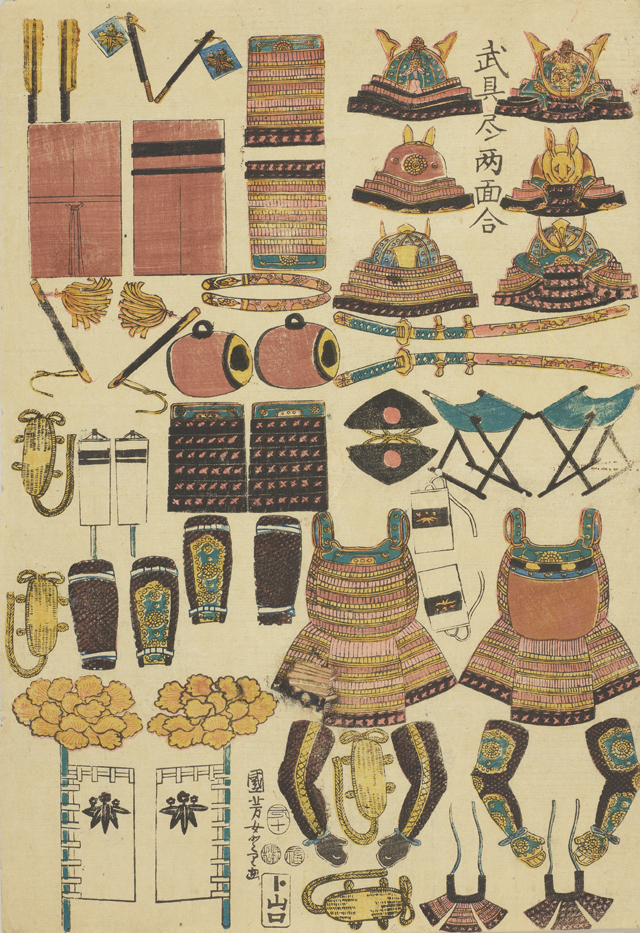
Utagawa Yoshitori “Both Faces Collection of Swords and Armors”
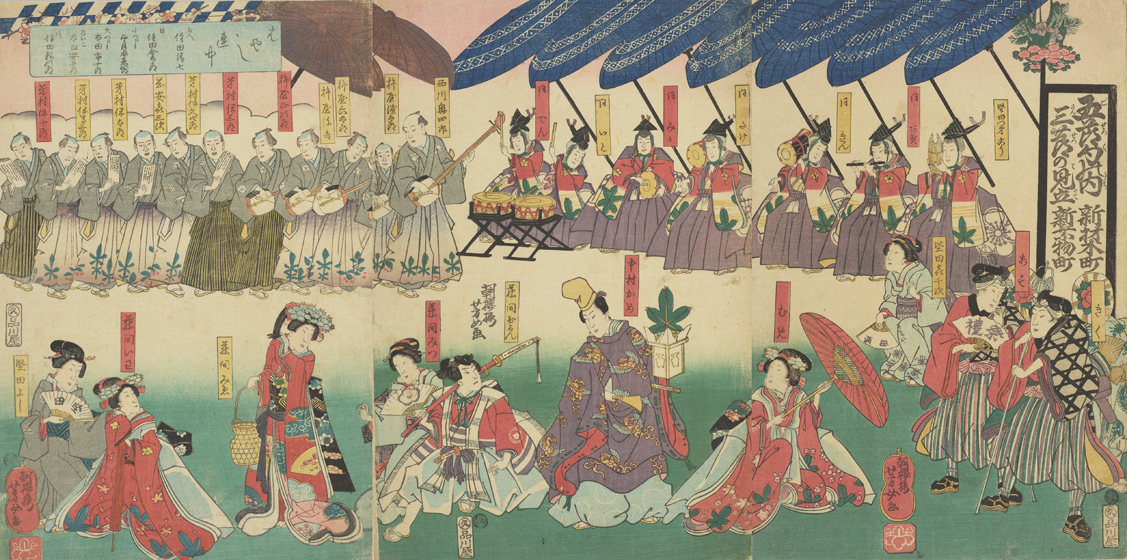
Utagawa Yoshijo “Festivals at Shin-zaimoku-Chō and Shin-norimono-chō in March”
A deep understanding of the history of ukiyo-e “Autumnfest of the Utagawa School”
At Ota Memorial Museum of Art, we will hold an exhibition of Utagawa Toyokuni, the master of Kuniyoshi in September, and an exhibition of ukiyo-e artists in the Meiji period including disciples of Kuniyoshi, such as Tsukioka Yoshitoshi, in November and December. Through the three exhibitions, you can trace the genealogy of the Utagawa school, inherited from Toyokuni to Kuniyoshi, and to Yoshitoshi. Ota Memorial Museum of Art, specializing in ukiyo-e brings to you this sequence of exhibitions for deeper understanding of the history of ukiyo-e.
- ①September 3rd-29th “Utagawa Toyokuni – A man who surpassed Sharaku”
- ②October 4th-27th “Utagawa Kuniyoshi -And his daughters”
- ③November 2nd- December 22nd “Last Ukiyoe -inheritors of ukiyo-e”
Highlight of the exhibition
Utagawa Kuniyoshi “Views of Edo: Eitai Bridge and Mitsumata Viewed from Nakazu”
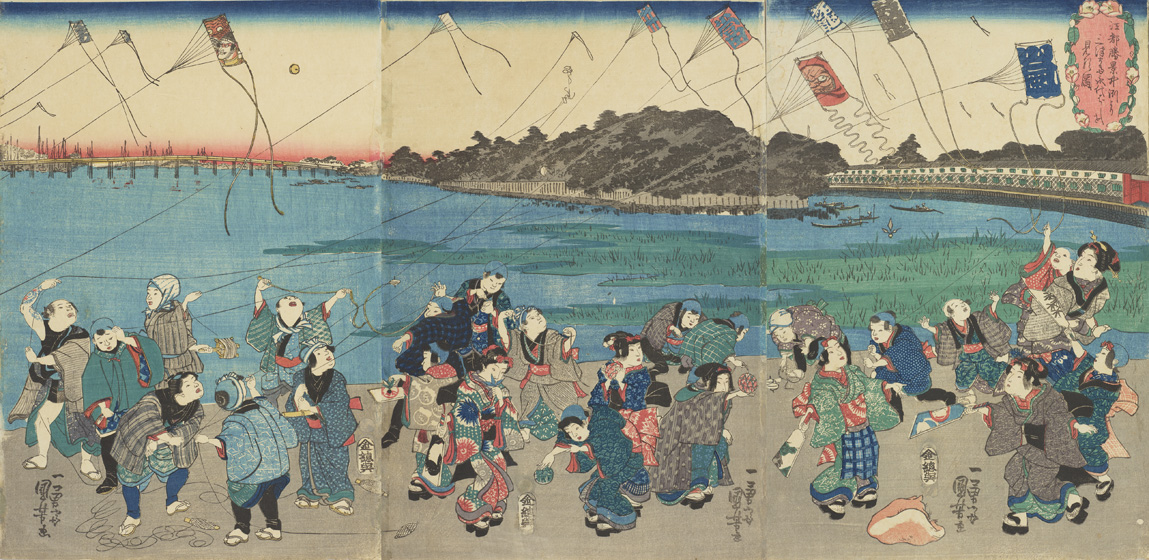
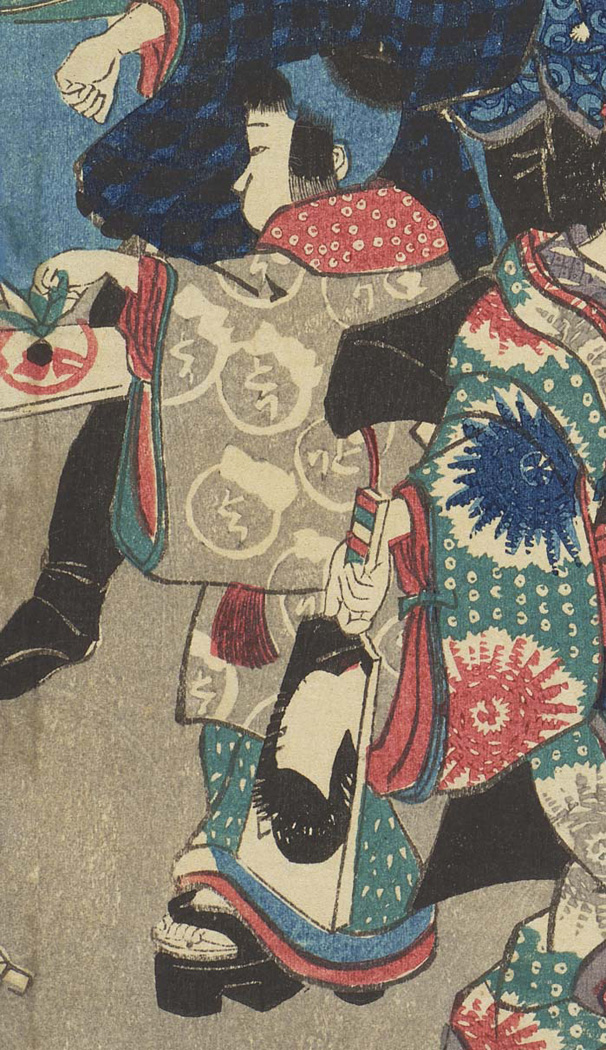
Represented is a scenery on New Year’s Day where children are flying kite and playing Japanese traditional badminton. Found on the kimono of one of the girls, is the signature used by the artists of the Utagawa Family and the word “tori.” From these subtle hints, the girl is considered to be Kuniyoshi’s first daughter “Tori”. Tori was about 3 or 4 years old when the picture was painted. As she was the daughter Kuniyoshi had after the age of 40, he might have drawn her secretly in his work for her cuteness.
Admission
| Adult | 700 yen |
|---|---|
| University and High school students | 500 yen |
| Junior High School Students and below | Free |
Closed
-
-
-
-
2019 October
SUN MON TUE WED THU FRI SAT 1 2 3 4 5 6 7 8 9 10 11 12 13 14 15 16 17 18 19 20 21 22 23 24 25 26 27 28 29 30 31
-
-
Utagawa Toyokuni – A man who surpassed Sharaku
2019, September 3rd-29thWill be closed on September 9, 17, 24.
Utagawa Toyokuni (1769~1825) is an ukiyo-e artist who played an active part in the field of yakusha-e (portraits of kabuki actors) and bijin-ga (pictures of beautiful women). He studied under Toyoharu, the founder of the Utagawa School. Since he published his representative series “Kabuki Actors on the Stage” in 1794, he stood out in the field of yakusha-e along with Tōshūsai Sharaku and Katsukawa Shun’ei. However, Toyokuni’s clear touch gained greater popularity than the others and he became a leading artist. In the field of bijin-ga, he competed with popular artist Kitagawa Utamaro. Compared to Utamaro’s amorous women, Toyokuni’s women were healthy and elegant, and this also attracted people. Moreover, he created illustrations for books energetically enough to vie with Katsushika Hokusai. Many talented young artists rallied around Toyokuni, who was a leading artist in various genres, and the Utagawa School became the biggest school of ukiyo-e at the end on the Edo period. This year commemorates the 250th year since his birth. Although Toyokuni played an important role as the master of Kuniyoshi and Kunisada, who are more recent popular ukiyo-e artists, exhibitions showing the entirety of his work have rarely been held. This exhibition introduces various genres of Toyokuni’s works and brings out their charms.
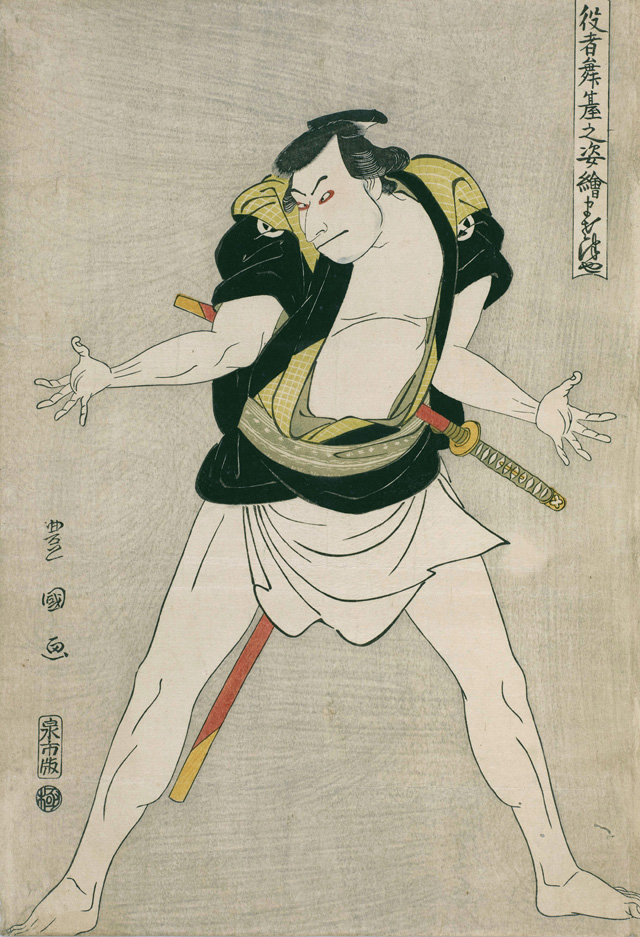
Utagawa Toyokuni “Kabuki Actors on the Stage: Masatsu-ya”

Utagawa Toyokuni “Kabuki Actor Ichikawa Komazō Ⅲ as Sasaki Ganryū”
Toyokuni’s yakusha-e, “Kabuki Actors on the Stage,” made him a front runner surpassing Sharaku
Toyokuni became a star artist in the genre of yakusha-e which portrayed Kabuki actors in Edo. His representative series of yakusha-e, “Kabuki Actors on the Stage,” published in 1749 attracted people with its refreshingly honest depictions of actors. In May of the same year, Tōshūsai Sharaku debuted with 28 bust portraits of actors made luxuriously with mica and published by Tsutaya Jūzaburō. This launched the rivalry between Toyokuni, Sharaku and Shun’ei, who were already big names in this genre. However, public interest toward Sharaku did not last long and he disappeared after about 10 months. Shun’ei, too, stopped making yakusha-e within a few years. Toyokuni, who gained both popularity and ability, became the leading artist of yakusha-e and pursued his own unique expression.

Utagawa Toyokuni “Kabuki Play “Sugawaradenju Tenarai Kagami” Kuruma-biki”
Bijin-ga works that competed with Utamaro – from women of samurai families to the lowest-ranked courtesans
Toyokuni was skilled at depicting not only kabuki actors but also beautiful women. Compared to Utamaro’s amorous women, Toyokuni’s women were healthy and elegant, and this also attracted people. Moreover, Toyokuni is also known for depicting women in various occupations and ranks such as women from samurai families, female farmers, high-ranked courtesans in Yoshiwara and the lowest-ranked courtesans working on boats in the illustrated book “Ehon Imayō Sugata”.
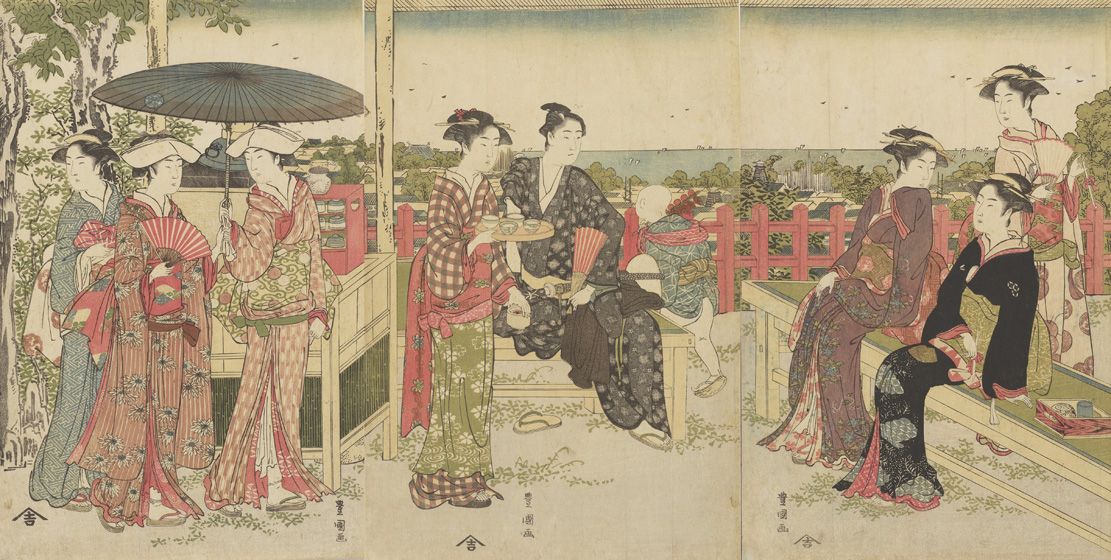
Utagawa Toyokuni “Summer View of Atagoyama”
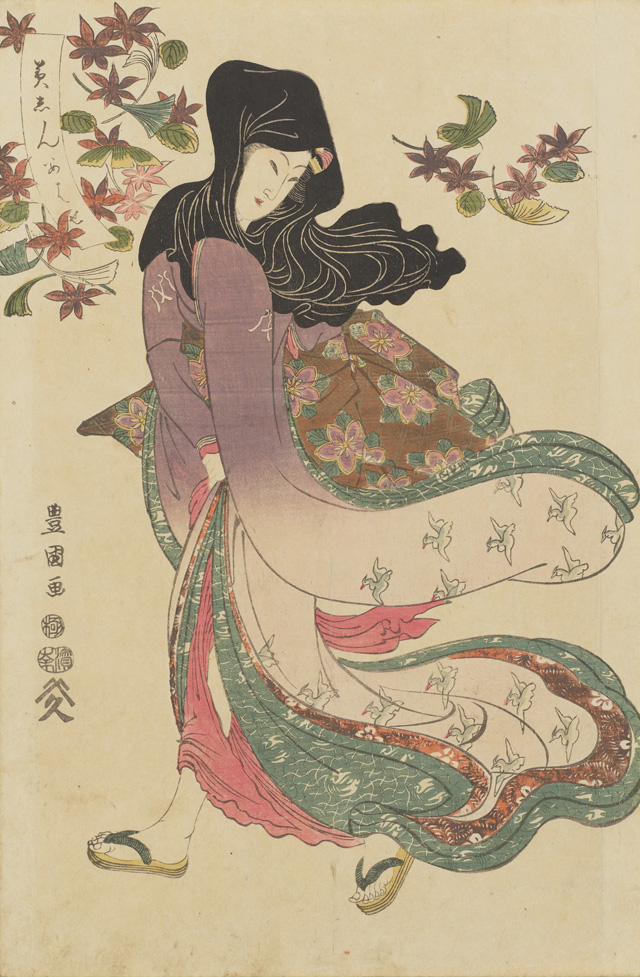
Utagawa Toyokuni “Collection of Beautiful Women”
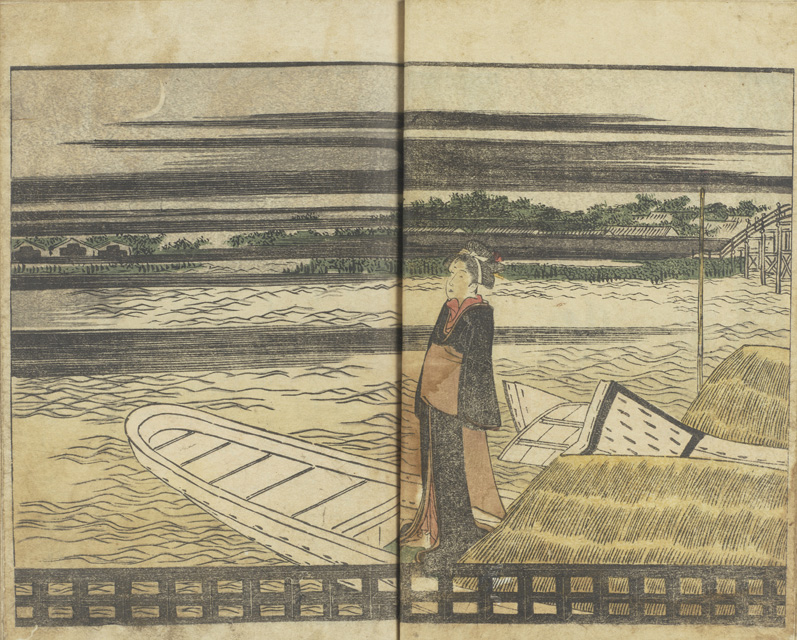
Utagawa Toyokuni “Illustrated Book “Ehon Imayō Sugata””
Book illustrations that competed with Hokusai – amusing anecdotes of popular artist Toyokuni
Toyokuni, who became a popular artist in the genre of yakusha-e and bijin-ga, competed with Hokusai in the various genres of illustrated books. He had many deadlines from various publishers, and was popular enough to be confined indoors working. However, he was not known as a quick worker. One story says that when Toyokuni was confined to his room in spring, he said he wanted to go see the cherry blossoms at the Sumida River and stopped drawing. The publisher brought a branch of cherry blossoms to Toyokuni’s room and he resumed drawing. There are many anecdotes that remind us of manga artists in the Showa period who were bold and openhearted.

Kyokutei Bakin/Utagawa Toyokuni Illustrated Book “Fukushū Kitan Wakae no Hato” (private collection)

Kyokutei Bakin/Utagawa Toyokuni Illustrated Book “Fukushū Kitan Wakae no Hato” (private collection)
The roots of Kuniyoshi? Toyokuni’s caricature pictures
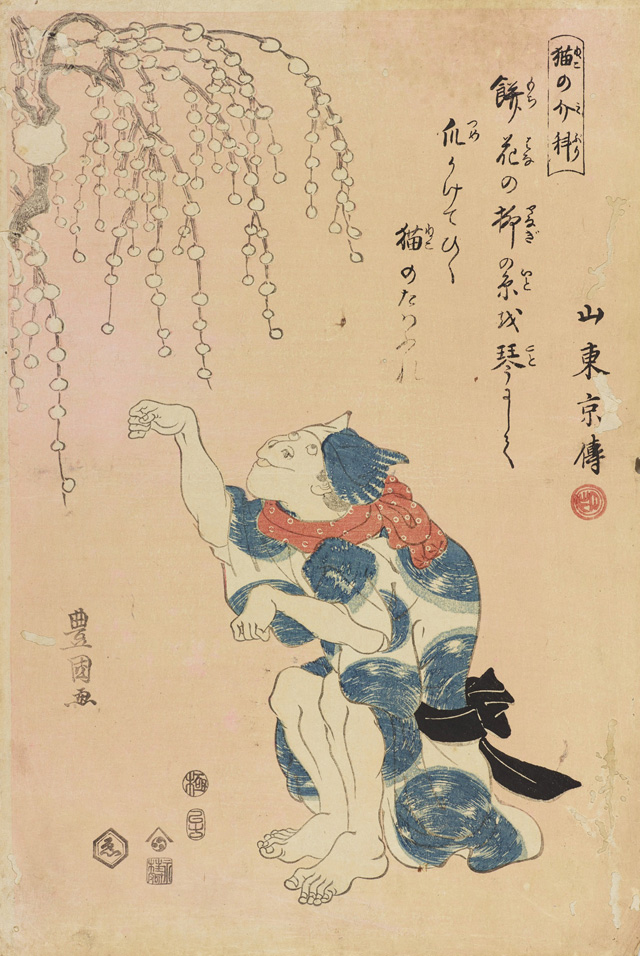
Utagawa Toyokuni “Mimicking a Cat” (private collection)
Although Toyokuni did not create many of them, he did leave behind some interesting parody pictures. This picture depicts a man pretending to be a cat. The man is playing with decorative New Year ornaments made of rice cakes. There is something amusing about Toyokuni’s humorous depictions of cats on towels and kimono. Toyokuni’s pupil, popular uikiyo-e artist Kuniyoshi, was skilled at caricature pictures and left many works featuring farcical pictures of cats. In this way, Toyokuni’s caricature pictures can be said to be the roots of Kuniyoshi.
Featured Work
Utagawa Toyokuni “Kabuki Actor Sawamura Sōjūrō Ⅲon the Boat at Night”
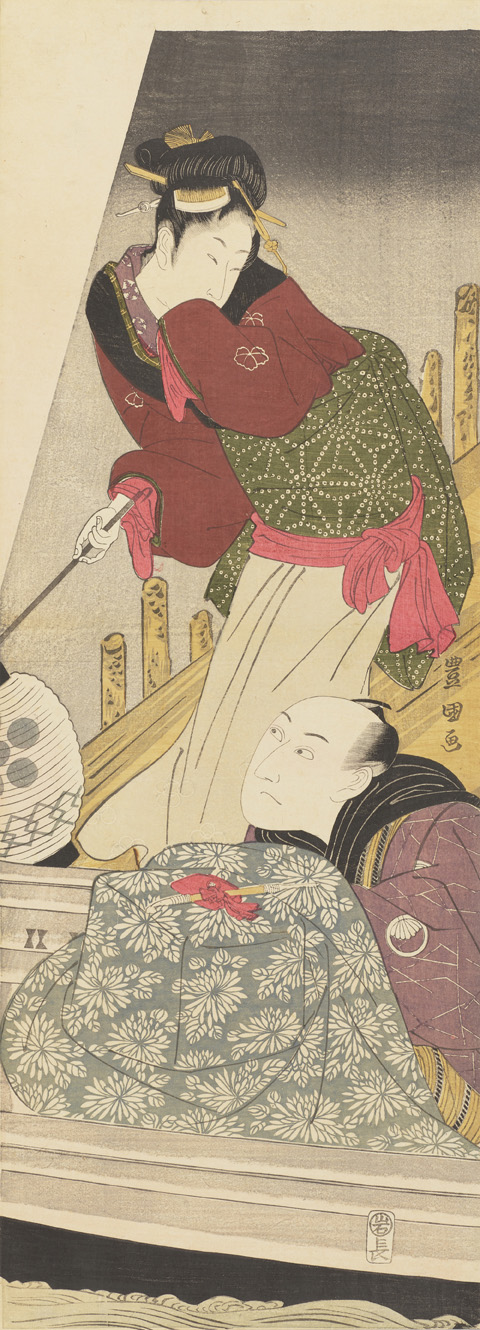
One of the series of pictures depicting the daily lives of popular kabuki actors with beautiful women. This picture depicts Sawamura Sōjūrō Ⅲ who is seating hunched, warming himself at a kotatsu (a small table with a heater placed underneath) on a boat. We can feel the coldness of the air from the picture. Since the woman standing on the dock looks surprised, she might have just noticed the figure of this famous kabuki actor. The gradation of black applied from the top expresses the night, and the depiction of the light from the lantern the woman is holding also makes an impact. This work is quintessential Toyokuni, showcasing his remarkable skill in both portraits of kabuki actors and pictures of beautiful women. Sawamura Sōjūrō Ⅲ was an active kabuki actor during 1789-1801 who was drawn by many ukiyo-e artists of this period such as Toyokuni, Tōshūsai Sharaku and Katsukawa Shun’ei.
Admission
Adult 1000 yen University and High school students 700 yen Junior High School Students and below Free Calendar
Closed
-
-
-
-
2019 September
SUN MON TUE WED THU FRI SAT 1 2 3 4 5 6 7 8 9 10 11 12 13 14 15 16 17 18 19 20 21 22 23 24 25 26 27 28 29 30 -
-
-
-
2019 August
SUN MON TUE WED THU FRI SAT 1 2 3 4 5 6 7 8 9 10 11 12 13 14 15 16 17 18 19 20 21 22 23 24 25 26 27 28 29 30 31 -
-
-
-
2019 July
SUN MON TUE WED THU FRI SAT 1 2 3 4 5 6 7 8 9 10 11 12 13 14 15 16 17 18 19 20 21 22 23 24 25 26 27 28 29 30 31 -
-
-
-
2019 June
SUN MON TUE WED THU FRI SAT 1 2 3 4 5 6 7 8 9 10 11 12 13 14 15 16 17 18 19 20 21 22 23 24 25 26 27 28 29 30
-
-
-
Walking the hills and valleys of Edo
2019, June 1st-26thWill be closed on June 3, 10, 17, 24.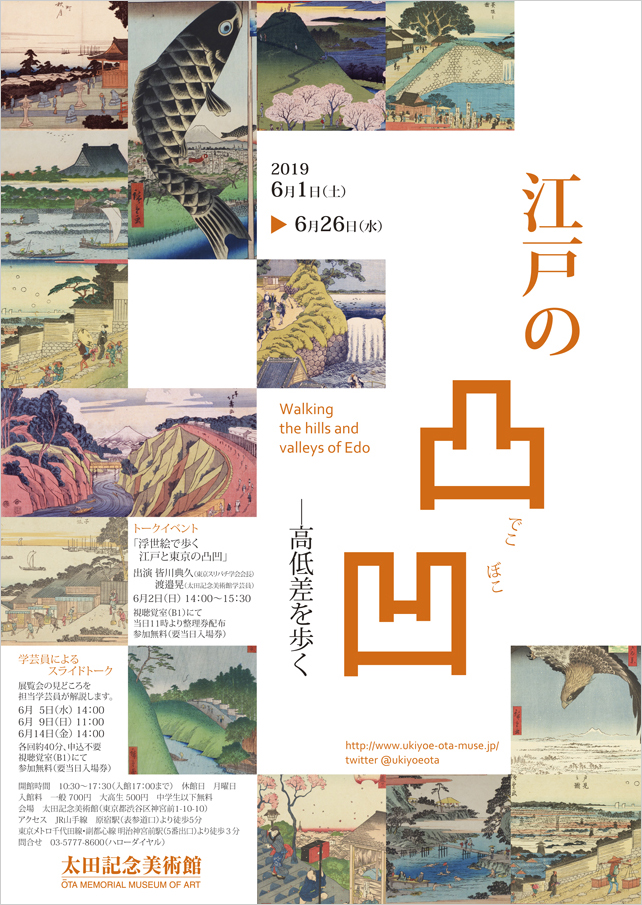 In recent years, walking around the city with its unique topographical aspects, such as high ground and low ground, slopes and undulating terrain, is often covered on television and in books, and has gradually gained a quiet popularity. We can enjoy a stroll in Tokyo while experiencing different elevations and the special characteristics of Musashino Plateau in the west, the low-lying land lying to the east, rivers such as the Kanda river and Meguro river and the valleys along the traces of the ancient rivers. Ukiyo-e artists such as Utagawa Hiroshige often portrayed the city of Edo with landscape pictures that demonstrated an awareness of these topographical aspects. Although the townscape is now greatly different from the Edo Period, the hills, valleys and slopes remain almost unchanged in present Tokyo. This exhibition focuses on such topographical features of Edo depicted in ukiyo-e. By looking at ukiyo-e and comparing the topographical characteristics of Edo and present Tokyo, we hope that you can feel much closer to the landscapes of Edo.
In recent years, walking around the city with its unique topographical aspects, such as high ground and low ground, slopes and undulating terrain, is often covered on television and in books, and has gradually gained a quiet popularity. We can enjoy a stroll in Tokyo while experiencing different elevations and the special characteristics of Musashino Plateau in the west, the low-lying land lying to the east, rivers such as the Kanda river and Meguro river and the valleys along the traces of the ancient rivers. Ukiyo-e artists such as Utagawa Hiroshige often portrayed the city of Edo with landscape pictures that demonstrated an awareness of these topographical aspects. Although the townscape is now greatly different from the Edo Period, the hills, valleys and slopes remain almost unchanged in present Tokyo. This exhibition focuses on such topographical features of Edo depicted in ukiyo-e. By looking at ukiyo-e and comparing the topographical characteristics of Edo and present Tokyo, we hope that you can feel much closer to the landscapes of Edo.
Shōtei Hokuju “Sea of Shinagawa Viewed from Atago-yama Hill at Shiba in Edo”

Utagawa Hiroshige “Famous Places in Edo : Cherry-blossom Viewing at Gotenyama Hill, Complete Map of Shinagawa”
Views from mountains and highland plateaus
Views from high places such as mountains and highland plateaus were often depicted in ukiyo-e as the subject of the landscape pictures of Edo. Many shrines and temples were located on the top of the mountains or on high ground that had good views, and these places were popular for their beautiful landscapes. Here, we will also introduce the places made by human hand to enjoy scenic views such as Fujizuka, an artificial mountain, and Sansō-dō Hall of Gohyakurakan-ji Temple.
Utagawa Hiroshige “One Hundred Famous Views of Edo : Suidōbashi Bridge and Surugadai”

Utagawa Hiroshige “One Hundred Famous Views of Edo : New Mt.Fuji in Meguro”
Walking around the valleys and lowlands
To the east of the city of Edo, low-lying areas spread out around Edo Bay and the Sumida River, and there are many valley-like landforms that can be seen at the edge of the higher ground and around the rivers. Moreover, land was actively reclaimed from the sea in the Edo Period. Hibiya is one place reclaimed from the sea in the early Edo Period, and Tsukiji is also a place located at a low sea level that was expanded by land reclamation. Here, we will introduce valley-shaped landforms and lowlands near water depicted in ukiyo-e.
Utagawa Hiroshige “Famous Places in Edo : Takinogawa, Ōji”
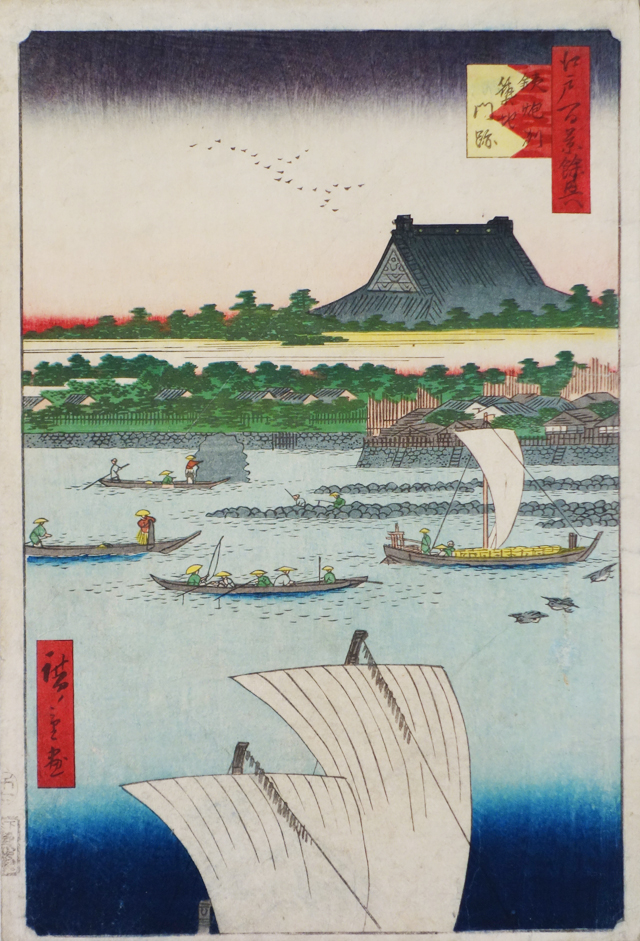
Utagawa Hiroshige “Teppōzu and Tsukiji Monzeki”
Slopes in Edo – connecting higher and lower places
When there is a topological gap, a slope connects the higher and lower places. Slopes are one of the most popular features for many people who like walking around Tokyo. Famous slopes are also the subjects of ukiyo-e pictures. Since many slopes still retain the same name in the present day, it might be interesting to visit those places after enjoying the view of the slopes in ukiyo-e.
Utagawa Hiroshige “Various Slopes in Edo : Shiomizaka Slope at Isarago”

Utagawa Hiroshige “Comical Views of Famous Places in Edo : No. 28, View of Gomizaka”
A bird’s eye view of the hills and valleys of Edo
Ukiyo-e artists often depicted the Edo city by imagining the view looking down from the sky. They portrayed landscapes with topographical characteristics such as mountains, valleys and water channels that were found throughout Edo city. Let’s take a look at some landscapes in Edo city drawn with the bird’s-eye view technique in this last section of the exhibition.
Kitao Masayoshi “Bird’s‐eye View Picture : Famous Places of Edo”
Highlight of the exhibition
Utagawa Hiroshige “One Hundred Famous Views of Edo : Seidō and the Kanda River from Shōheibashi Bridge”
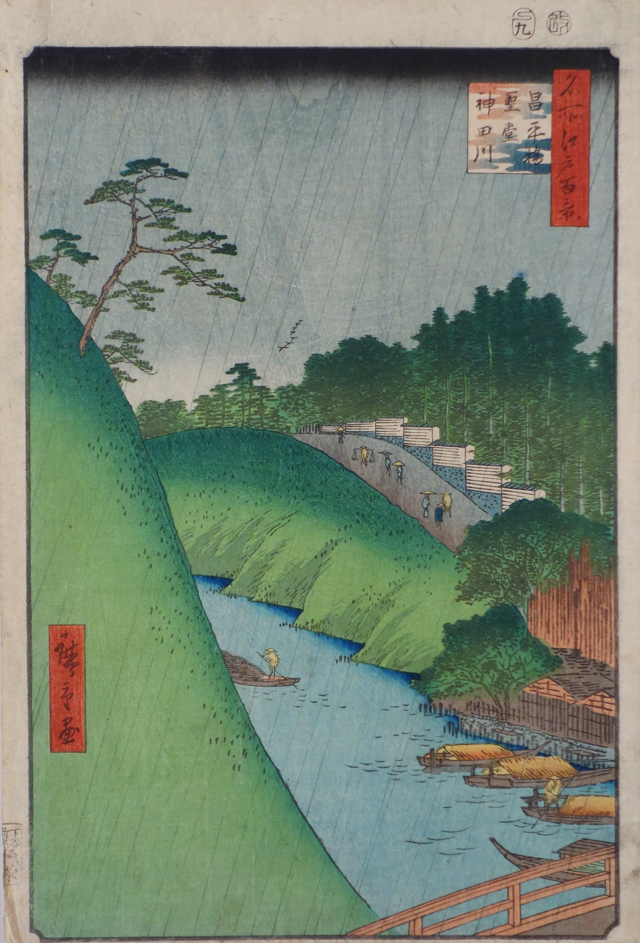
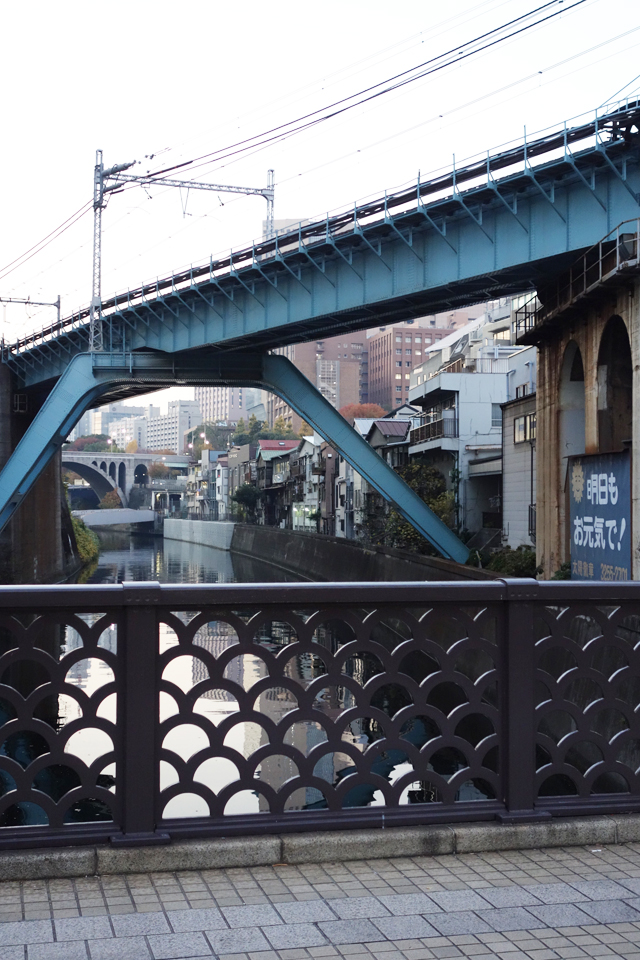
The picture shows the viewpoint from Shōheibashi Bridge with the Kanda River flowing past in front and Yushima Shrine on the right. A huge sheer cliff is seen on the left. The area around Ochanomizu, known as one of the best landscapes in the city with its rich topographical characteristics, was actually an artificial valley created through the public works in the Edo period. This area was originally a highland plateau called Kandayama, and Sendai Domain was ordered by the government to create the Kanda River by clearing the land. It was completed in 1661, the era of Date Tsunamura. It is said that Date Masamune was also involved in this construction. From the view of the landscape and the picture, we can imagine the monumental effort of Sendai Domain, and the high level of engineering skills in the Edo period at the same time.
Admission
Adult 700 yen University and High school students 500 yen Junior High School Students and below Free Calendar
Closed -
-
-
Life with blue – Kimono, pottery and daily articles
2019, July 2nd-28thWill be closed on July 8, 16, 22.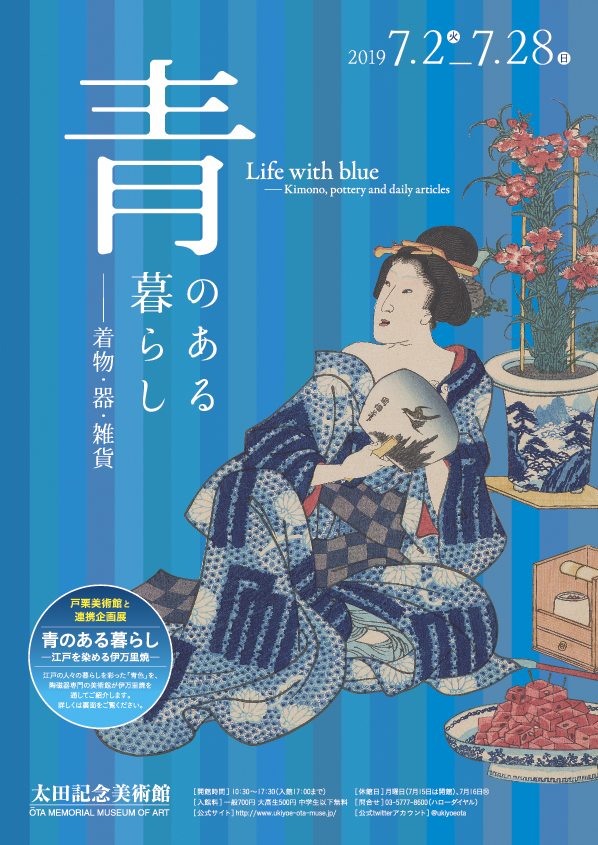
The color “blue”, which reminds us of the beautiful sky and sea, fascinated the people in the Edo Period, and brought a refreshing splash of color to their lives. In particular, thanks to the abundant supply of cotton and improvements in dyeing technology, the indigo shade called “Japan blue” in the present day spread widely and came to be used for yukata (light cotton kimono), tenugui (cotton cloths) and noren (store curtains). Furthermore, blue-colored tableware and flowerpots called sometsuke became popular, and blue became a color used in various scenes of daily life. There are a surprising number of ukiyo-e prints depicting Edo people incorporating blue into their daily lives. In this exhibition, we will introduce “the culture of blue” fostered in the Edo Period through pictures which captured the daily life of Edokko (people in Edo) as well as landscape pictures by Katsushika Hokusai and Utagawa Hiroshige.
The Ota Memorial Museum of Art, specializing in ukiyo-e, and The Toguri Museum of Art, specializing in ceramic ware, have collaborated for the first time, going beyond the genre of Art. We hope you will enjoy the lifestyles of Edo filled with beautiful blue through the perspectives of ukiyo-e and ceramics.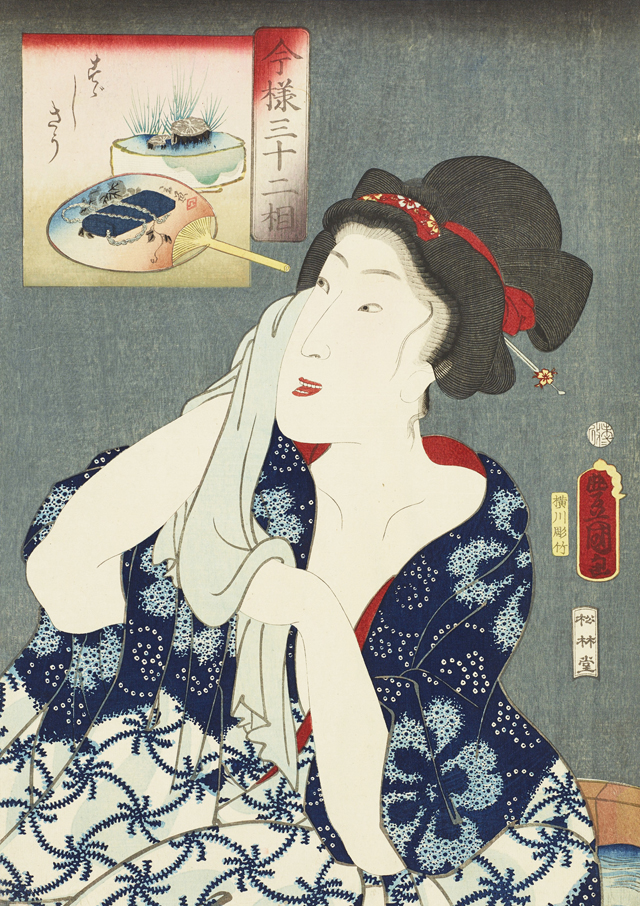
Utagawa Kunisada “Thirty-two Appearances of Contemporary Women: Looking Cool “
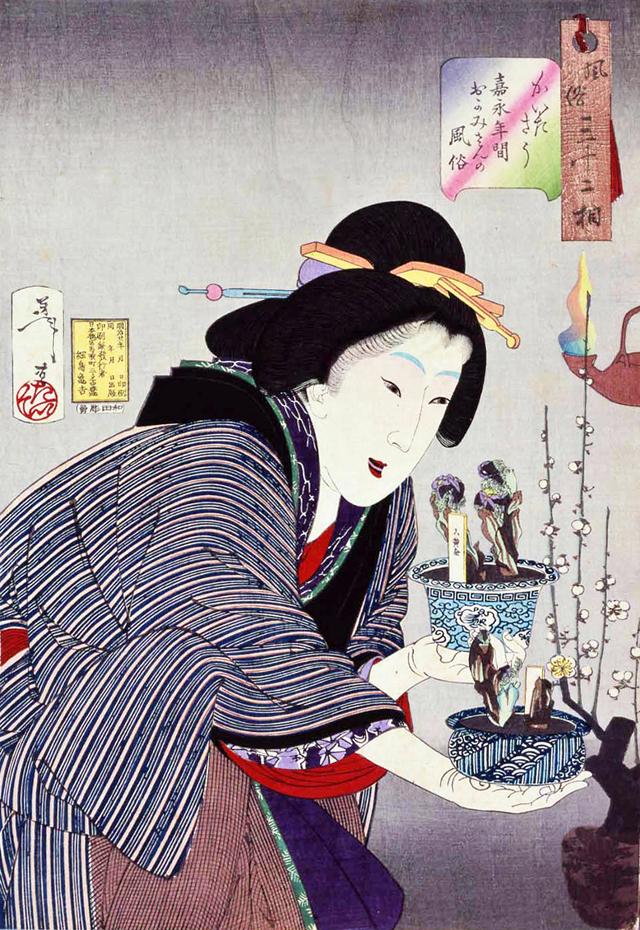
Tsukioka Yoshitoshi “Thirty-two Aspects of Women: Looking as if She Wants to Purchase, Appearance of Housewives of the Kaei Period”
Blue in fashion
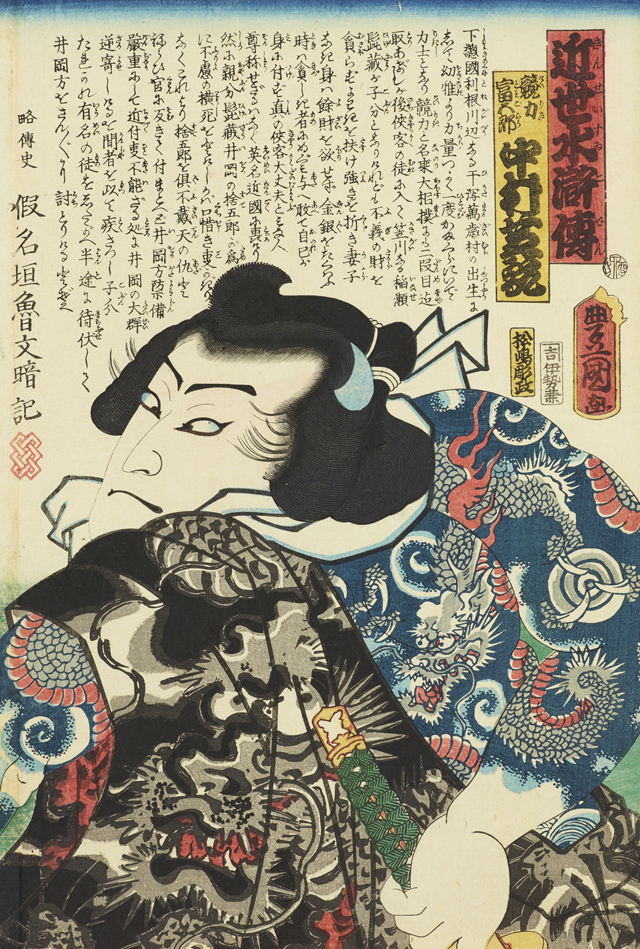
Utagawa Kunisada “Kinsei Suikoden: Kabuki Actor Nakamura Shikan Ⅳ as Keiriki Tomigorō”
The color of the uniform of the Japanese national soccer team is called “Samurai blue”, which features a deep shade of blue originating from traditional indigo. With the distribution of indigo, ukiyo-e in the late Edo Period captured the appearance of various people wearing blue as daily clothes. In this section, we will introduce various fashions using blue in Edo, especially yukata (light cotton kimono) which features beautiful contrasts between blue and white. Women wear yukata with not only cute patterns but also bold designs such as crabs and octopuses, and men present cool and chic figures with yukata. Moreover, we will introduce manly beauty at that time through the pictures depicting tattoos which gained popularity in the late Edo Period.

Utagawa Kunisada (Toyokuni Ⅲ) “Twelve Months: June, Airing Clothes”
Blue coloring life
In the late Edo Period when food, fashion and gardening cultures that continue even today started blooming, people used various pottery and daily articles such as dishes, rice bowls, flower pots and cotton towels, with many of them colored in blue. It can be said that blue colored life and was loved by people back then. Furthermore, a Greek writer, Lafcadio Hearn (Koizumi Yakumo), also wrote about the charm of Japanese scenes with copious amounts of blue used for the house roofs, clothes and store curtains that he saw when he came to Japan in 1890. From this section, you can understand that sense of how Japanese people loving blue was nurtured in the Edo Period.
Japan blue that fascinated the world
It seems that the Western people who visited Japan in the Meiji Period found the culture of blue developed in the Edo Period to be unique to Japan. Originally, the person who named the blue color ingrained in Japanese life “Japan blue” was a British chemist Robert William Atkinson who came to Japan in 1874. Furthermore, a Greek writer Lafcadio Hearn (Koizumi Yakumo) also wrote about the charm of Japanese scene with a lot of blue used for the house roofs, clothes and store curtains that he saw when he came to japan in 1890.
Ukiyo-e blue revolution
Landscape paintings with the beautiful blue sky and the ocean of Katsushika Hokusai and Utagawa Hiroshige have fascinated many people all over the world. Behind the birth of the world-class ukiyo-e landscape paintings of Hokusai and Hiroshige was the appearance of a new blue paint called Berlin blue (Prussian blue). It made it possible to delicately express the changing sky and the subtle surface of water. We will introduce the changes of expression related to the new blue painting in ukiyo-e history by exhibiting landscape paintings from before and after its use became common.

Katsushika Hokusai “Thirty-six Views of Mt. Fuji: Hongan-ji Temple at Asakusa in Edo”
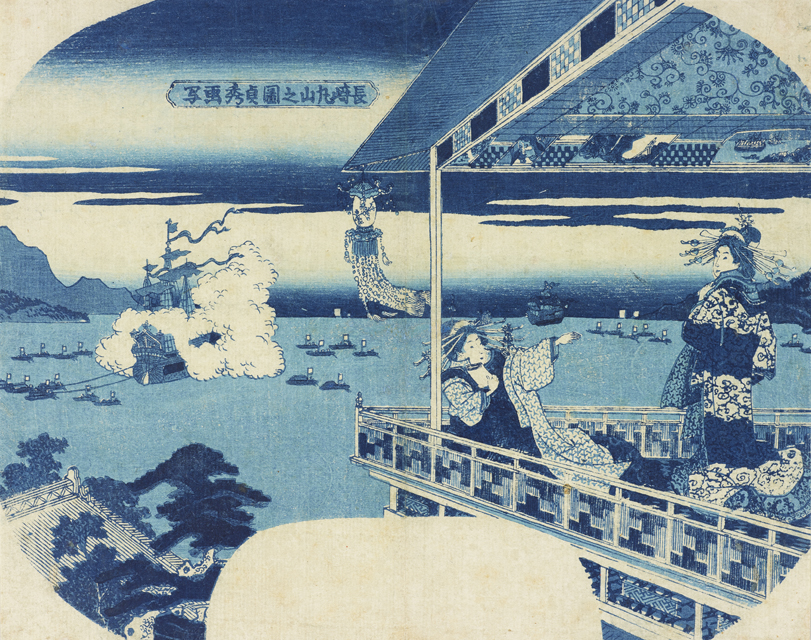
Utagawa Sadahide “Coutesans Viewing the Port of Nagasaki”
Featured Works
Utagawa Hiroshige “One Hundred Famous Views of Edo: Dyers’ Quarter, Kanda”
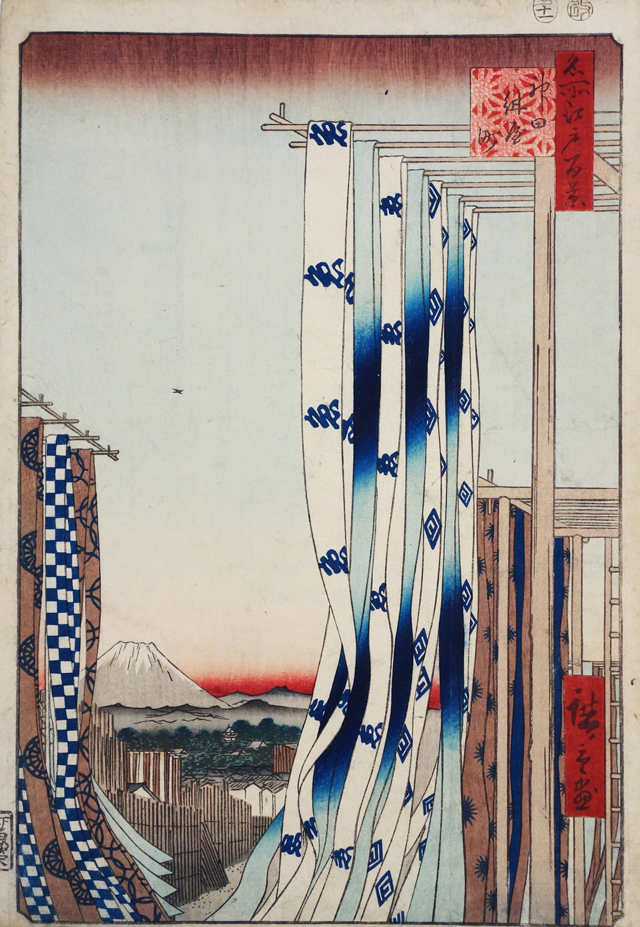
See Edo Castle and Mt. Fuji fluttering in the wind on fabric dyed shades of blue and brown. Kanda Kon’ya-chō was governed by Tsuchiya Gorōemon, the head dyer who was allowed to buy the indigo fabrics throughout the Kanto district. It was named after the fact that there were many dye artisans living in this area. The appearance of the fabrics being hung at the drying space must have been a common sight in this region. The fabrics dyed with various patterns such as characters, color gradations and checkerboard patterns, show how people tried to seek out various patterns and how the dyers responded to those needs.
Admission
Adult 700 yen University and High school students 500 yen Junior High School Students and below Free Calendar
Closed
-
-
-
Invitation to different worlds – Specters, the spiritual world and foreign countries
2019, August 2nd-28thWill be closed on August 5, 13, 19, 26.
Ukiyo-e mostly depicts subjects of the pleasurable yet fleeting “ukiyo” (real world) such as popular kabuki actors and courtesans, as well as famous sites crowded with people. However, the real world is not the only subject of ukiyo-e. In some ukiyo-e paintings, landscapes of worlds which are completely different to those of the world we live in, and characters from these worlds are featured. In this exhibition, we will guide you through the various worlds depicted in ukiyo-e paintings with three themes – specters, the spiritual world and foreign countries. We hope you enjoy the encounters in the unreal worlds.

Tsukioka Yoshitoshi “Ban Danemon Naoyuki Defeating Specters Disguised by Raccoon Dogs”

Utagawa Yoshifusa “Yoshihira’s Ghost Destroying Namba Jirō at Nunobiki Waterfalls”
Specters – Encounters with odd-looking creatures
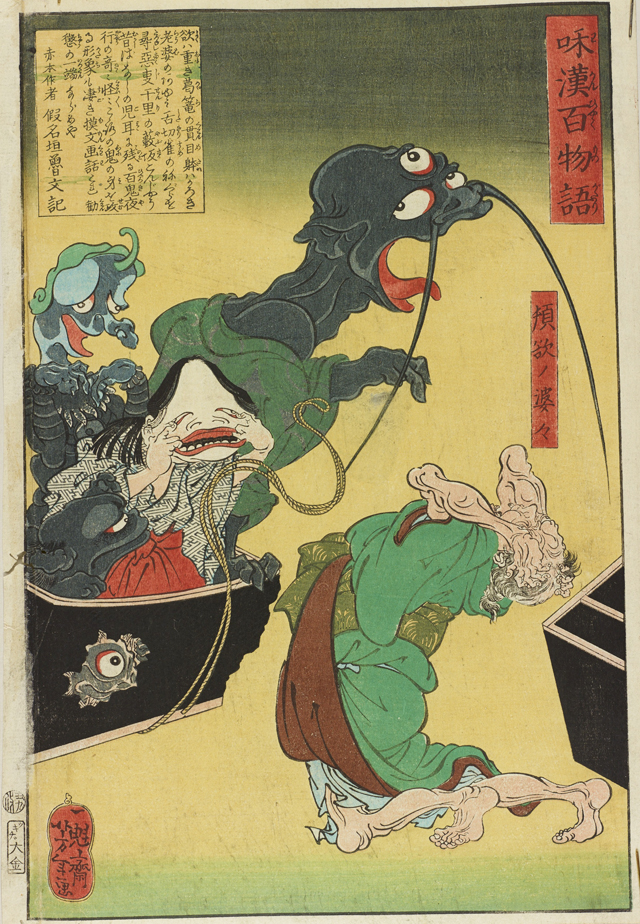
Tsukioka Yoshitoshi “One Hundred Ghost Stories of Japan and China: Insatiable Old Woman Opening a Box Filled with Specters”
Specters attempting to scare, or attack people are often depicted in ukiyo-e. Their appearances can be tremendously horrifying at times and humorous at others. There are also ukiyo-e of people confronting these odd-looking creatures without fear and defeating them. In this section, we will introduce the various monsters that come from different worlds.
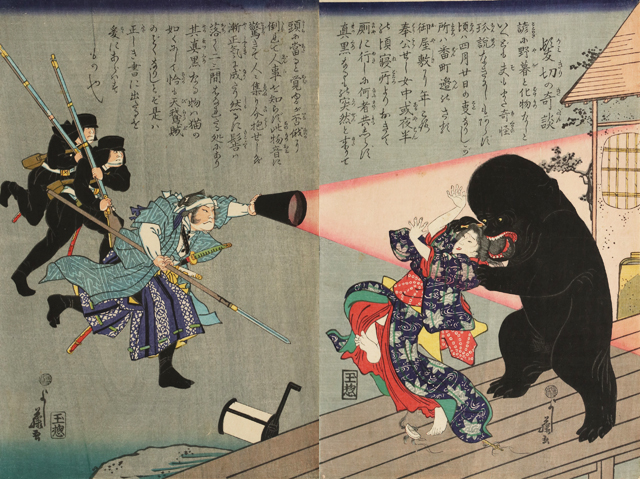
Utagawa Yoshifuji “Monster Cutting Woman’s Hair”
The spiritual world – Ghosts risen from the underworld

Utagawa Kuniyoshi “Kabuki Actor Ichikawa Kodanji Ⅳ as Ghost of Oiwa”
Stories of people coming back to this world as ghosts after being killed by villains were often performed in kabuki plays and made into ukiyo-e portraits of the kabuki actors. There are also peculiar works which depict the judge of the afterlife and demons being defeated by a dead person raging in hell. Here, we will introduce ghosts and the world after death depicted in ukiyo-e, as well as the memorial portraits to commemorate the people who had died, called “shini-e.”
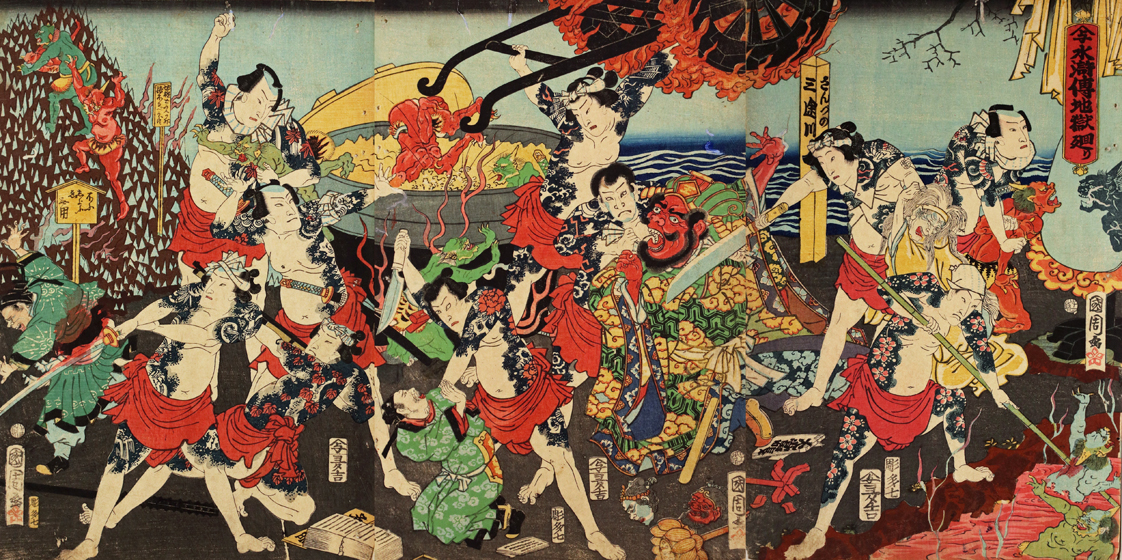
Toyohara Kunichika “Kabuki Actors Discipline Ogres at Hell”
Foreign countries – landscapes based on hearsay and imagination

Utagawa Kunitora “European Ships Going into the Bay of Rhodes”
For people in the Edo period who had never been abroad or rarely had direct interactions with foreigners, foreign countries were beyond their imagination. The sceneries of these foreign countries were depicted in ukiyo-e, referring to limited documents, pictorial information, and sometimes fanciful imaginations. In this section, we will introduce works picturing Okinawa and Hokkaidō which were not part of Japan at the time, landscapes of China and Europe far across the ocean, and the foreign technologies such as steamships, trains and hot air balloons introduced to Japan at the end of the Edo period through the Meiji period.

Utagawa Yoshitora “View of America”
Featured Work
Utagawa Kuniyoshi “Pairs for the Fifty-three Stations of the Tōkaidō Road: Kuwana, Sailor Tokuzō Looking at a Sea Goblin”
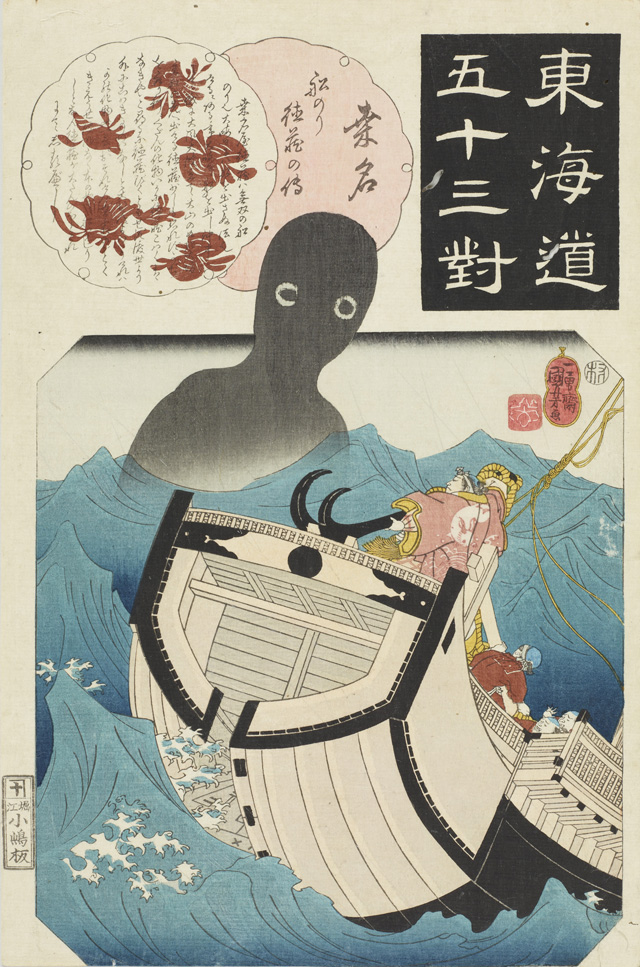
A sailorman Kuwana Tokuzō ignores the rule that he should not set sail on New Year’s Eve and encounters a huge sea monster called “umibōzu” offshore. Umibōzu asked Tokuzō if he was scared, but contrary to the expectation of umibōzu, he answers that living in this world is much scarier. Umibōzu was awed by Tokuzō of what he said and disappeared. With umibōzu depicted with only dim eyes in a black shadow, this is an impressive work of the creepy appearance of umibōzu coming from a different world.
Admission
Adult 700 yen University and High school students 500 yen Junior High School Students and below Free Calendar
Closed
-
-
-
-
